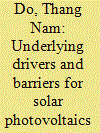|
|
|
Sort Order |
|
|
|
Items / Page
|
|
|
|
|
|
|
| Srl | Item |
| 1 |
ID:
190643


|
|
|
|
|
| Summary/Abstract |
At the United Nations Framework Convention on Climate Change 26th Conference of the Parties (COP 26) in November 2021, Vietnam pledged to phase out unabated coal power by the 2040s or as soon as possible thereafter. Achieving this will require major efforts. This study investigates the drivers for Vietnam's coal power phase-out decision, barriers to Vietnam achieving a successful unabated thermal coal phase out, and potential strategies to achieve the pledge. To this end, a survey of 43 experts from government agencies, research institutions, civil society, and industry was carried out, supplemented by 23 follow-up interviews. The results indicate that ambition to attract international support for green growth initiatives in a context of limited financing options for new coal power projects appears to have been the primary driver for the decision. Key barriers include concerns about electricity shortages and incomplete regulatory frameworks for new clean power options. Recommended strategies include: 1) reforming regulations to facilitate investments in clean energy, electricity transmission, and energy storage; 2) continuing political prioritisation; and 3) building broad-based support from the community and enterprises. Vietnam's case is relevant to other developing countries and beyond.
|
|
|
|
|
|
|
|
|
|
|
|
|
|
|
|
| 2 |
ID:
176873


|
|
|
|
|
| Summary/Abstract |
Vietnam experienced a solar photovoltaic (PV) installation boom in the first half of 2019, with installed capacity increasing to 4,450 MW. This saw Vietnam overtake Thailand to have the largest installed solar PV capacity in Southeast Asia. This paper investigates the underlying drivers of Vietnam's solar boom, barriers to further solar adoption, and suitable strategies for the next stage of solar adoption. Forty-six semi-structured interviews were conducted with experts from government agencies, international organizations, non-governmental organizations, universities, research institutions, and industry. A generous feed-in tariff (FIT) of US$93.5/MWh for new projects, together with supporting policies such as tax exemptions, are found to be the key proximate drivers of Vietnam's solar PV boom. Underlying drivers include the government's desire to enhance energy self-sufficiency and the public's demand for local environmental quality. Limited transmission grid capacity and complex administrative procedures are among the key barriers. Looking forward, Vietnam has substantial potential to continue to scale up solar PV, with market-based mechanisms able to play a large role in this process. Vietnam's case is relevant for broader energy transition discussions.
|
|
|
|
|
|
|
|
|
|
|
|
|
|
|
|
|
|
|
|
|